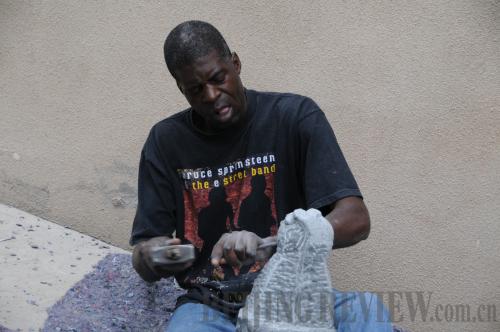|
 |
|
Artist Tendayi Chidakwa is chiseling the "Friendship" sculpture on-site in Lanzhou, capital city of Gansu Province (COURTESY OF GANSU MUSEUM) |
From August 12 to September 12, over 100 pieces of Zimbabwean stone sculpture were exhibited in "Nature's Creation: Stone Sculptures From Zimbabwe," an art showcase at Lanzhou's Gansu Museum in northwest China.At the opening ceremony two Zimbabwean artists presented a sculpture called "Friendship" to China's Ministry of Culture. The gift was made on site by the two sculptors within three days of their arrival in Lanzhou, capital city of Gansu Province.
"We decided to make one here, because we want our Chinese friends to see how we make things back home," said Nestbert Mukora, the artist and manager of N. M. Curious Limited, a Zimbabwean stone sculpture company.
Nature's creation
The exhibition's stone sculptures were produced by over 20 artists in Ruwa, a town situated 22 km southeast of Harare, the capital of Zimbabwe. The art is amazingly beautiful with each stone containing rich colors and textures, displaying great individuality in form and content. The sculptures emphasize nature and the essence of life.
Because the Shona people are Zimbabwe's oldest and most populous tribe, the sculptures are also called Shona sculpture. The name "Zimbabwe" is derived from the Shona term "dzimba dza mabwe," meaning "house of stone." Over 250 ore types are found in Zimbabwe, which makes it the only African country with significant deposits of stone suitable for carving. The country has a long legacy of stone-carving traditions.
"We are world leader in stone sculpture. I think any person [viewing the] sculptures can see that [they are a] display [of] particularly fine artistic talent," David Coltart, Zimbabwe's Minister of Education, Sports, Arts and Culture, told ChinAfrica proudly.
The sculptors usually work in outdoor studios. A simple array of tools are used, including hammers, files, chisels and sandpaper. Depending on the form, color, striations and contours of the stone, an artist carves a sculpture without sketches or drawings, shaping it into images they have seen in daily life, in meditation, or even in dreams.
Inspiration and creativity
Sculptors draw extensively on Shona mythology, folklore, rituals and beliefs for ideas. Some sculptures depict people's daily lives – working, dancing or playing – while others portray animals like frogs, birds, giraffes, elephants and fish, as well as the natural world and man's relationship with nature. Women are also a significant source of inspiration.
Tendayi Chidakwa, a Zimbabwean sculptor, told ChinAfrica that some of the pieces he creates come from dreams. "While sleeping, I could dream of a piece. When I [wake] up, the first thing I [do] is to take my tools, look for a [suitable] stone, and then I [create] it. Sometimes it [takes] me a week thinking of it, trying to revise [the image from] the dreams," he said.
The time one sculpture takes all depends on the size of the stone, and the sculptor's artistic process. Sculptors believe that every rock contains a spirit that influences how the stone will be shaped and transformed during carving.
"For us, the stones mean something, and they talk. It's the creativity in the carving process that distinguishes [our sculptures] with others. There is a story behind every piece of sculpture," Mukora added.
Winning Chinese audiences
"Apart from performing arts, we also need to include visual arts [in the Zimbabwe Culture Week], as Zimbabwean stone art [rises] in the world. I think a culture that has inspired many world-renowned artists such as Picasso will also [inspire] Chinese people," said Yu Peng, Deputy Director General of the Bureau for External Cultural Relations, the Ministry of Culture.
The exhibit attracted a rapt local audience. Some visitors took photos with the life-size sculptures, while others got so excited they even started touching and kissing the works. "I have seen some wood sculptures brought back by my friends from Zimbabwe, but it's my first time to see the stone sculptures," said He Li, an art lover who is a local civil servant.
The exhibition was part of the city-wide "African Cultures in Focus 2010: Zimbabwe Culture Week" that ran between August 12 and 19, an event jointly organized by the Gansu Provincial Government and five Chinese government agencies including the Ministry of Culture.
China as a potential market
"We are very proud that our work is being exhibited in China. It's a very good opportunity," said Mukora. "Because of the language [barrier], it was difficult for us to do business with China in the past, but now it's much easier."
Mukora said they would be joining other Zimbabwean artists at the Shanghai World Expo. They want to do as much marketing as they can and explain their sculptures to Chinese audiences to help them understand. "It's part of our marketing [strategy]," he explained.
Minister Coltart echoed Mukora: "Art can be a constructive and positive feature of society, and its promotion internationally is a critical component of Zimbabwe's rebranding exercise." The hope is that the exhibition will launch a market for Zimbabwean art in China. |